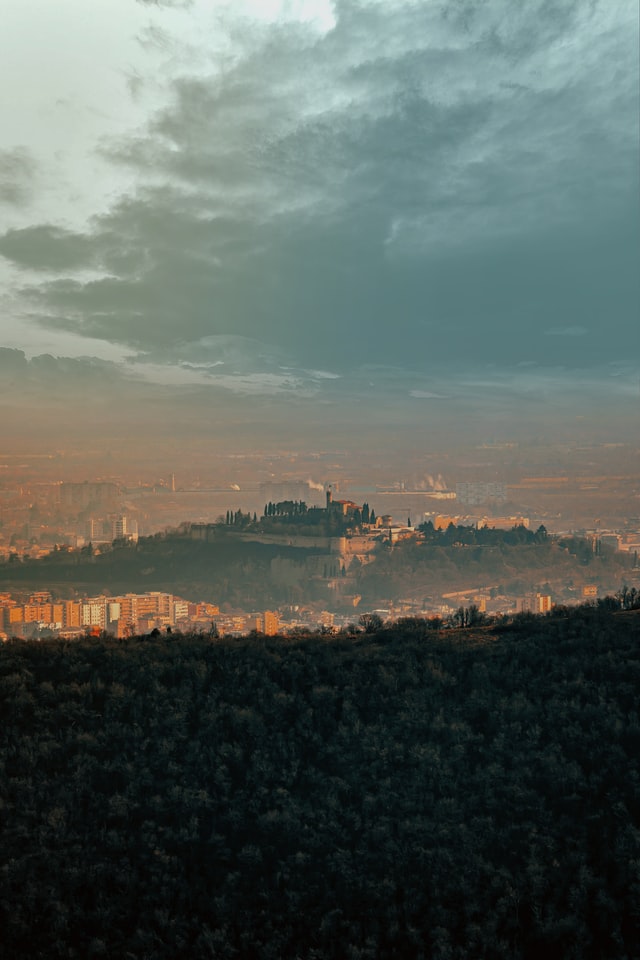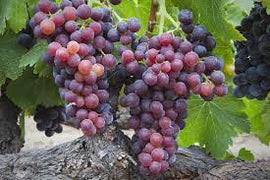Lombardia
Lombardia (aka Lombardy) crowns Italy’s central northern boundary, bordering Switzerland to the north, but its influence reigns much larger. With around 10 million inhabitants, it is by far Italy’s most populous region; Milan, the capital, is one of the largest urban areas in the EU, the country’s financial and industrial hub, and a center for Italian fashion, art, design, architecture, media, music and tourism. Lombardy as a whole is responsible for 22% of the country’s GDP, and boasts an economy about the size of Belgium’s. So it’s not surprising that wine may not be the first thing that comes to mind when considering the place. But as with every other corner of the country, Lombardy possesses its share of unique and venerable winemaking traditions - and plenty of local vintners farming indigenous grapes on some variegated and absurdly gorgeous landscapes. It’s a very nice place to spend some time.
Lombardy can trace its wine tradition back to the pre-Roman Etruscans, who had already refined wine production techniques. From 568-774 A.D, the Germanic Longobardi tribes settled in the region, providing the name by which it has been known ever since. Today, Lombardia is made up of twelve provinces: Bergamo, Brescia, Como, Cremona, Lecco Lodi, Mantova, Milano, Monza-Brianza, Pavia, Sondrio and Varese. Its geography is split almost evenly between mountains and plains, with the Po Valley occupying 47% of the territory. The weather varies due to the diverse terrain, but it is generally considered a ‘cool’ continental climate, influenced by several geographic features, like the Alps located in the north, and the Po River which runs along the Oltrepò Pavese and forms most of the region's southern border with Emilia-Romagna. The most significant winemaking regions are Valtellina in the Alps, known for its age worthy take on Nebbiolo (known locally as Chiavenesca); Oltrepò Pavese in the far southwestern corner, scrunched between Piemonte and Emillio Romana,; and the aforementioned Brescia, in the east, which is responsible for Franciacorta, the sparkling white that is likely Lombardy’s best known oenological product.
Brescia also covers part of the Lugana appellation, a small diamond shaped DOC, just south of Lake Garda (Italy’s largest), that straddles both Lombardy and the Veneto regions. It is defined by a fairly flat basin bounded on the north by Lake Garda and on the west, south, and east by low morainic hills that were formed by the southern push of the great Alpine glaciers of the Ice Age. The uniform clay soils, the temperature-moderating influences of the large lake, and the confining hills combine to create a clearly distinct terroir, ideal for mineral driven whites made from the local Trebbiano di Lugana grape (also known as Turbiana, and genetically identical to Verdicchio.) Our white this month is a Lugana from the Marangona winery, named for the bell that was rung to signal the end of the workday. Established in the early ’70s in an old farmhouse from 1600, it is today owned by Alessandr Cutolo, a young winemaker who has embraced organic and sustainable philosophies in the vineyards and in the cellar. He works exclusively with indigenous varietals and ‘Cemento’ is his top bottling, made with fruit from his oldest vineyards.
Our red comes from the Buattafuoco (“spit fire” in Italian) appellation. The DOC is relatively new, even if the tradition it codifies goes back centuries. The communes of Buttafuoco are located about 100 miles directly east of Turin and 40 miles south of Milan, within two valleys in the aforementioned (and much larger) Oltrepo Pavese. Buttafuoco is a red blend that must consist of 25% Barbera and 25% Croatina, with a maximum of 65% of either. Ughetta di Canneto (also known as Vespolina), along with Uva Rara, are allowed but not required. Each grape can impart specific characteristics to the final product: Croatian provides the shoulders and the tannins; Barbera, the acidic drive and bright intensity, while the Ughetta di Canneto contributes spice and a balsamic note, and Uva Rara some gentle aromatics. A native of the area, Andrea Picchioni started his winery from scratch in 1988 and his respect for the land is deep and extremely progressive from an ecological standpoint. Everything is organic certified, and the weed management is performed by hand with a no-till farming practice. Picchioni even tries to offset his carbon footprint by putting all the nature taken from his vineyards (save the wine itself), like grape pomace and mulched vine clippings, back into the vineyards and employing mechanization only when necessary. Much of the property he owns is still forested in order to compensate for his carbon emissions.
Salut,
Alan Hicks
Wine Buyer
Noe Valley
|
Region: Lugana, Lombardy |
About the Winery: The Lugana appellation is around the base of Lake Garda, one of the most beautiful places in Italy. Cemento is Marangona’s top bottling of Lugana, made of the fruit from their oldest vineyards. Originally this bottling was partly aged in wooden barrels, but Alessandro isn’t a big fan of oak, so he bought some high-quality conical tanks made of food-grade cement to experiment with. Cement tanks were common say 50 years ago, then were largely replaced by stainless steel; in the last few years, however, the benefits of cement are being appreciated again, particularly when it is unlined (as these are) and can ‘breathe.’ Alessandro was very happy with this experiment and decided to use this fermentation method to make his flagship wine. He had always used the word ‘cement’ (cemento) to describe the experiment, and now it’s the name of the bottled wine too.
About the Winemaking: 100% Turbiana (Trebbiano di Lugana, Verdicchio) Certified organic From vines planted between 1969 and 1978 on soils of calcareous clay and silt. Harested September 10 through mid October. 8 days maceration, controlled low temperature fermentation in cement with selected yeasts Aging: 10 months in cement on the lees, 8 months in bottle Fined with bentonite and gelatin, sterile pre-bottling filtration, natural cold stabilization 3,000 bottles produced annually. 100% Turbiana (Trebbiano di Lugana, Verdicchio)
Tasting Notes: Cemento shows a bright pale straw color in the glass, with aromas and flavors of mint, white peach, apricot and sage. The texture is outstanding, with richness from the skin contact balancing the zesty acidity of old-vine Turbiana. An excellent white wine. |
|
Winemakers: Alessandro Cutolo |
|
|
Price per bottle / Price per case $30 $324 |
|
|
Suggested Food Pairing: Works well as an aperitif or with: Bigoli con le sarde (Pasta with sardines) Smoked salmon Pumpkin Tortellini |
|
|
Region: Solinga Valley, Buttafuco, Oltrepo Pavese, Lombardy |
About the Winery: Picchioni’s steep vineyards are located in the Solinga Valley (Sun Valley), an amphitheater with an east end opening and the original home to the historic Buttafuoco wine. A document from 1861 verifies the name of this unique site as Vigna Buttafuoco, and it’s shared with only one other grower on the hill. The structure of the valley is able to hold onto the sun’s heat for a while longer (before the cold rolls in) than in the more exposed sites further south and outside of the Buttafuoco communes. The result of the heat is stressed vines that render wines of strength and depth. The Solinga valley is full of wild, dense forest and this is felt and tasted in the nuances and energy of his wines.The soils in the Solinga Valley are compacted sands with a mix of small and medium-sized, extremely hard granite-like igneous cobblestones with a high content of quartz and loads of organic matter in the topsoil—a result of Picchioni’s no-till farming! About the Winemaking: Manually harvested and completely destemmed, the grapes are co-fermented as it was done in the past—a technique demonstrated in many cellars that seemingly renders a more seamless wine without an obvious separation between the blending materials in the finished product. Vinified with natural yeasts in concrete vats. Sulfites are added prior to fermentation and then after malolactic fermentation; the SO2 level never exceeds 60mg/l (60 parts per million). Aged in entirely in concrete vats for eight months. There is no fining but a light filtration is made at bottling. 60% Croatina, 30% Barbera, 10% Ughetta di Canneto
Tasting Notes: Bright ruby red color with violet highlights. Nose with dog rose and wild fruits notes, and freshly harvested hay hints. Well-rounded, velvety and harmonious on palate. Long finish. |
|
Winemakers: Andrea Picchioni |
|
|
Price per bottle / Price per case $26 $312 |
|
|
Suggested Food Pairing: Local Pasta dishes such as Risotto alla Pavese (see recipe) Tortellini di Valeggio Polenta Grilled and Roasted Meats |
|
Risotto alla Pavese
Creamy risotto made with fresh cranberry beans is a Lombardy staple. With traditional flavors from the region, this risotto is bursting with flavor and healthy goodness. Cranberry beans are also called borlotti beans. They are considered 'the poor man's meat' due to their nutritional value.
Ingredients
- 6 cups vegetable broth
- 18 ounces fresh cranberry beans, shelled
- 3 tablespoons olive oil
- 3 tablespoons butter
- 1 small onion, diced
- 1 clove garlic, minced
- 1 sprig fresh rosemary
- 1 fresh bay leaf
- 1 sprig fresh sage
- 1 ¼ cups uncooked carnaroli rice
- ½ cup dry white wine
- ¾ cup tomato sauce
- Pour vegetable broth into a large saucepan and bring to a boil. Add fresh cranberry beans and return to a boil. Reduce heat and simmer until beans are soft but not mushy, 20 to 25 minutes. Remove beans with a slotted spoon, leaving the vegetable broth over the heat source on medium-low.
- Heat olive oil and butter in a large saucepan over medium-high heat. Add onion, garlic, whole rosemary sprig, bay leaf, and sage. Sauté until onion is soft and translucent, about 7 minutes. Add rice and stir to toast the rice, 2 to 3 minutes. Once rice is toasted, add drained beans and stir until well coated.
- Add white wine and stir until wine is fully absorbed. Add 1/2 cup broth to the rice and stir until the broth is absorbed. Continue adding 1/2 cup of broth at a time, stirring continuously, until the liquid is absorbed and the rice is al dente. Add tomato sauce and stir until creamy and thick. This whole process will take about 18 minutes.
- Remove risotto from the heat source and let stand for 2 minutes. Remove rosemary twig, bay leaf, and sage and serve.





